Freight Operations - Non Passenger Coaching Stock - Parcels and
Post Office Traffic
Railway parcels (as opposed to parcels being carried on behalf of the
General Post Office) were a special high value category of sundries traffic,
The volume of this traffic was sufficient for it to be carried separately from
the main railway goods traffic either in the guards compartment of passenger
trains or in special trains of parcels vans, mainly bogie stock. The railway companies operated dedicated fleets of road vans (horse drawn and later motor) to collect and deliver parcels although at small country stations it was usual for the customer to deliver to, or collect from, the station themselves.
Entire trains of parcels stock were operated between the major stations
and were a regular feature of railway traffic from about the turn of the
century. These trains were composed of assorted full brake coaches, bogie, six
wheeled and four wheeled vans. In N Graham Farish GUV's and full brake coaches,
Lima CCT (a four wheeled van designed to carry cars but which was mainly
used for parcels traffic) and siphon vans, Dapol GWR siphon vans and some kits (such as the P.D. Marsh SR Utility Van
) may be pressed into service for general parcels
stock (The Lima and Dapol vans are illustrated in the section on Available Models and the former Fleetline SR vans may be reintroduced in the Lytchett Manor Models range if the molds prove up to the required standard.).
Lima offered their four wheeled BR CCT van in standard BR maroon and also in Tartan Arrow livery. Tartan Arrow Services was a company set up in late 1966 which operated an overnight delivery service between London and Glasgow. They had depots at which goods were packed containers (at least some of which were in Tartan Arrow livery), these containers were then taken to the station on flat-bed trucks and craned onto railway wagons. I have not yet found information on the containers used but the ISO container was by then in use and Triang released some of their standard 30-foot containers in Tartan Arrow livery. For consignments of less than a ton in weight they also leased a number of BR parcels vans and CCT vans which were painted with their livery. The consignment could be collected by Tartan Arrow lorries or taken to the depot by the sender. The vans and container wagons were initially attached to regular BR services but from 1967 they formed a 'company train' 1300 feet (400m) long and often if not usually steam hauled. I think the parcels vans were at the front and containers at the back. At the destination the vans were passed into a company operated parcels depot and the containers were transferred to a yard equipped with a gantry crane for transfer back onto delivery lorries. I have seen mention of one the CCT vans appearing in a general parcels rake passing through Manchester Piccadilly in the late 60s but the Tartan Arrow service was discontinued in about 1970 and the vans were then dispersed so they could show up anywhere on the London Midland Region in general parcels traffic. The Tartan Arrow livery had largely disappeared by the early 1970's but odd examples may have lingered on. I do not know when they were phased out (the only information I was able to
find was in a chronology on the Model Rail Express website which confirmed the start up date).
Fig___ Sketch of Early ISO style container in Tartan Express livery (based on the Triang model

Tim White sent me a scan of an article on the computerisation of the new Tartan Express service with an artists impression of the terminal. The illustration showed a single track entering the building which seemed unlikely, the sketch below is based on that drawing. Note there was an awning shown on one side but not on the other. From a modelling perspective assuming the train was split equally between container flats and vans a two-road shed would need to be close to two feet long (60cm) in N gauge and there would be another two tracks of similar length for the container side.
Fig___ Sketch of a Tartan Express terminal for van traffic
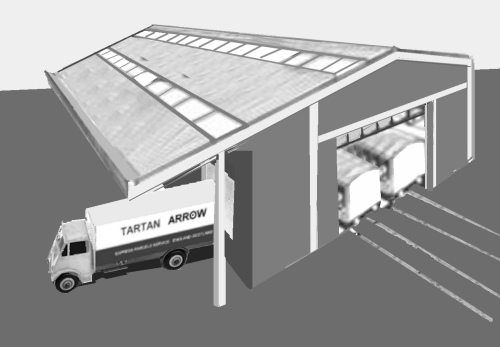
From the late 1950's purpose built parcels railcars were built,
based on the standard passenger multiple units of the time these were called
DPUs. More of these were provided in the 1980's by converting redundant DMU
stock, the seats were removed and, in some cases the engines were replaced. A
few of these conversion had vertically operating roller doors fitted to improve
access. Although theoretically efficient these DMU's proved problematic due to
their age and unreliability, all DPUs were withdrawn from service in 1990, all
parcels trains thereafter being hauled by locomotives.
Fig___ Class 128 (WR) Parcels Railcar in early 1960s BR livery
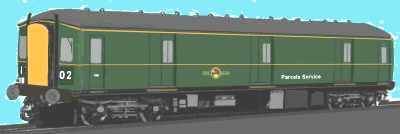
See also Appendix Three - Passenger Stock - Coaches and multiple units for more information on DPU stock
Railway parcels were booked in from an office on the passenger station, at suburban and rural stations a set of platform scales was usually seen outside the entrance to the parcels office (see also Wagon Loads & Materials Handling - Yard and platform clutter). There were restrictions on the size and weight of goods accepted as parcels, I believe it was about 55lbs (25Kg) maximum weight and 6ft (2m) maximum lengths, so you could not send a roll of carpet as a parcel. Any item heavier or larger than this was only accepted as 'sundries' and would be dealt with at a goods yard.
At the branch
line station the parcels were loaded and unloaded from the guards compartment
at the normal passenger platform as the stopping passenger train passed
through. In town stations a platform was often dedicated to handling parcels
and in cities there was often a dedicated 'parcels depot' resembling a
passenger station with long platforms to allow access to the vans but usually
with somewhat less ornate architecture. These were located close by the passenger station and often formed an extension to that station.
One characteristic feature of
these operations were the four wheeled trolleys used to move the mail bags and
parcels about on the platforms. All railway companies had these but they were
designed for use carrying luggage. British Railways developed a wire caged trolley with a low floor which was intended to replace all the existing platform luggage trucks and mail bag trolleys. This was christened BRUTE (British Railways Utility Trolley Equipment) and was produced in large numbers from the mid 1960's. See also Wagon Loads and Materials Handling - Materials Handling - Platform Trucks and trolleys for more on this equipment.
In 1966 the
railways own parcels business was separated from the general merchandise
sundries traffic and on January 1st 1969 the railway
Sundries Division became National Freight Carriers. National Freight Carriers took over the
ownership of the railway owned road transport. At the time the railways were
operating nearly ten thousand motor vehicles and twenty three thousand trailers
but following the transfer of ownership they were progressively re-liveried
with the National Carriers Limited logo on the side.
Fig___ Ex BR road vehicles in NCL livery

The photo below is from a 1970s BR publicity leaflet, it shows a parcels depot at a major railway station (actually part of a passenger stations, although the platforms used were dedicated to this traffic), the van in the background has the NCL logo.
Fig___ Parcels traffic at a major station
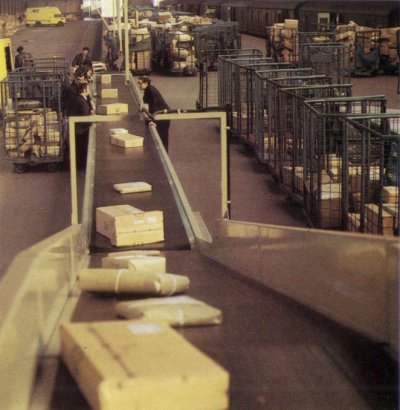
Although most of the goods depots were subsequently closed
down British Railways own parcels trains, depots and the associated road
collection and delivery services were maintained in co-operation with NFC/National Carriers until 1981.
After
1981 the only sundries traffic handled by BR was the Red Star parcels service
(which had been introduced in 1963). Red Star was set up to move parcels in the guards
compartment of passenger trains, the parcels were dropped off and collected at
the station by the customer. The service used express passenger trains and had the slogan 'Send your parcels Red
Star and pull out all the stops'. The Red Star service was efficient, in the
1980's I was working for a shipping company and we made regular use of the Red
Star system to get urgent spares from one end of the country to the other
overnight (often rather quicker, I remember picking a package up in (I think)
Middlesborough at about 1 am that hadn't left the office until after 6 pm).
Thanks to the interconnection of the various European railway services Red Star
also offered an international service, operating from Victoria station in
London, delivering parcels to railway stations on the continent. In the sectorisation of 1987 Red Star became
part of the BR Parcels Sector. I gather that by this time they had started using stopping trains for some of their services, which had an adverse effect on their timing and reliability.
Express parcels in the 1990's was a sector growing at 20 percent per year,
fueling the rapid privatisation of the parcels elements of the nationalised
sector (Red Star on the Railways, Lynx the parcels sector of the National
Freight Corporation and Post Office Parcelforce). Red Star was sold to a
management buy-out in 1995 (having failed to attract any worthwhile offers from
the business community. The newly formed Red Star Parcels Ltd then offered
people a franchise in which the franchisee paid them a substantial sum to
purchase the right to operate the service at a station. In spite of concerns
about additional road traffic the government decided that Red Star should not
be tied exclusively to rail and the company also utilised road and air
transport when this was viable. I believe the privatised Red Star service
delivered to about 200 stations nation wide. At the time it was sold off the
Red Star service was loosing money, to boost the sales they introduced a
door-to-door service using white vans bearing the Red Star logo and the new
slogan 'Faster by Far'.
Fig___ Red Star sign

In January 1999 Red Star was purchased by a
company called Lynx Express, an existing parcels delivery company. At this time there were around 130 Red Star offices still
functioning, Lynx Express planned for Red Star to continue to trade under its
well known brand, forming part of the Lynx Express Group but remaining as a separate legal
entity. Lynx Express was itself the privatised version of the parcels business of National Freight Carriers (who marked their vehicles National Carriers Ltd) and which was in turn the hived-off less-than wagonload railway sundries business. The Lynx Express parcels service saw
rapid expansion following the successful management buy-out in 1997, becoming
the largest single parcels carrier in the UK and a major player in the
international market.
In 2001 Lynx Express informed its customers of the closure, following a
review of their commercial viability, of a number of Red Star Parcel Points,
described as 'peripheral locations'. I believe that the remaining Red Star
network was shut down in 2001, although with the way the railways were privatised this is not surprising. As far as I can see Red Star seems to have been
dropped as a brand, it certainly has no presence on the internet that I could
find and I have not seen a red star office since the mid 1990's (there was a
franchise operating from Stockport station south of Manchester in about 1996 or
possibly 97). The company continues to exist, it now trades as Lynx Express and has been licensed by Postcomm (the postal services regulatory authority) but as far as I am aware they make no use of rail transport.
Post
Office Parcels
The Post Office was not originally allowed to
handle parcels and the railway companies resisted any move to allow it to do
so. The Post Office Parcels Act of 1882 allowed the GPO to enter into this
business and they began offering a parcels service from 1883. Post office
parcels soon became a major user of the railways for long distance parcels
traffic but the two parcels services were never combined and separate railway
company parcels trains continued to operate.
Four wheeled platform trolleys were also used for Post Office letters and parcels traffic, these were often based on standard railway company trucks but always painted in GPO red, the example below has high ends added specifically for parcels and mail bag work. It was still in use at Stockport station for mail services in the 1990s. The yellow and white trolley seen beside it was a passenger luggage trolley, intended to assist passengers getting between the taxi rank and the platforms.
Fig___ Mail bag trolley
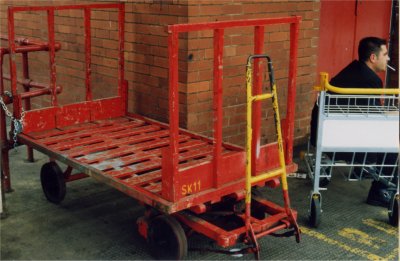
In 1969 the GPO ceased to
be a government department and became a nationalised industry and in 1981 the
GPO was split into British Telecom (telephones) and Royal Mail (letters and
parcels). In 1990 Royal Mail Parcels became Parcelforce, and a new distinctive
livery was introduced for its road vehicles.
The high volume parcels
traffic carried on behalf of the Post Office survived the cuts in the early
1960's but was lost to roads in the mid 1980's other than some long haul
containerised business handled by Freightliners Ltd. By the late 1980's Post
Office parcels were making a come-back on the railways, most of the old
dedicated parcels depots had closed down but the traffic can be handled from
conventional railway stations. In the 1990's parcels trains were still operated
on behalf of the Parcelforce, but the stock used was painted in the standard
red and yellow Royal Mail livery. In the late 1990's the EWS Eurospine wagons
carrying specially built road trailers were being used for long haul
Parcelforce traffic. These trailers are loaded and unloaded from the wagons at
goods terminals and travel in standard scheduled freight services.
Royal Mail Letters
On the early railways mails were carried in
normal passenger trains from the opening of the Liverpool & Manchester
Railway in 1830 (GPO horse drawn postal delivery carts had been in use for
rural deliveries since 1890). Within a few years a mail sorting coach
(converted from a horse box) was in use on the Grand Junction Railway (see
Historical Background section) to allow the mail to be sorted on the move. Flat
wagons carrying standard post office road coaches were in use on several lines
at least into the 1850's but the idea of sorting mail on the move in a
converted coach was a great success and more services soon appeared.
Not all railway postal services were a success, the Liverpool to
Manchester postal service transferred back to road in 1894, the road coaches
had a staff of two, both armed with revolvers (the firearms were dispensed with
following the introduction of private contractor motor vehicles in 1902, the
GPO purchased its first motor lorries in 1919).
An Act of Parliament
was passed in the 1830's giving the post office certain powers, they could
require railway companies to provide special coaching stock (although these
always remained the property of the railway not the post office) and they could
require certain train time tables not to be altered without prior consultation.
Delays caused arguments with the Post Office so from the late 1830's special
mail trains were run and from about 1885 all mails were carried in these
special trains, although some included a single first class only passenger
coach. These trains were called Railway Post Offices (RPO's) up to 1928, after
that they were known as Travelling Post Offices (TPO's).
There are two
basic kinds of coach used for mails, the sorting vans in which Post Office
employees sort and bag the collected mail en route and the 'stowage van', which
is simply a large vehicle for carrying mail bags. Additional stowage was often
provided by attaching railway company standard vans, mainly full brake coaches
or Goods Utility Vans (GUV's). Most of the coaches provided for mails were
based on standard designs but there were various experiments, one sorting coach
built by the Cornwall Railway had a papier-mâché body but this was
not considered a success. The dedicated Post Office coaches are usually
distinctive, as well as a range of liveries they have often featured recessed
sliding side doors and off-centre corridor connections so they can only be
marshalled together. The sorting vans usually have a posting box built into
them so passengers can post last minute mails on the platform, letters posted
in this way are franked with the name of the TPO service on which they were
posted.
Various inventors devised systems for getting mail on and off
a moving train but in the 1840's a post office worker came up with a mechanism
that was accepted by the General Post Office. The mail bags were strapped into
leather pouches (weighing up to 60 lbs or 27 Kg) which were then suspended with
special spring clips either from a ten foot high track-side post or from the
mail coach on a swinging arm arrangement. The collection gear on the coach
consisted of a net supported on a strong wooden frame which could be extended
out of the side of the TPO coach to collect the leather mail bags hanging on
the track-side post. Bags could also be dropped off from the arm on the coach
into similarly retractable track-side nets and most installations had both the
post and the receiving net apparatus. TPO coaches could have up to four
dropping-off arms, each mounted beside a doorway, the track-side apparatus
often had two arms mounted close together. For reasons I am not clear on this
equipment was known as 'traductor apparatus'.
Fig ___ Sketch of an
early six wheeled Travelling Post Office coach (based on an early NER vehicle),
showing collection and delivery apparatus for mail bags.
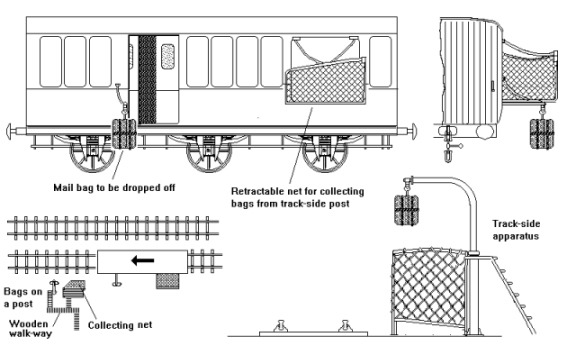
One of the things
apprentices had to learn on this job was to count the beats as the coach passed
over the rail joints after a given landmark so the out going bags, suspended
from the traductor apparatus, could be swung out for collection and the net
could be extended in time to catch the bags without being left out longer than
needed. The introduction of continuously welded rail, shortly before the
withdrawal of these services, put an end to this useful `trick of the trade'.
The collection system was phased out in 1971 and the associated vans had the
collecting nets removed and the openings plated over but the bay in the side of
the coaches where the net had been remained clearly visible. A preserved coach,
with the equipment fitted, may be seen in action at the Dinting Railway Centre.
Early vehicles were conversions based on standard four and six wheeled
coaches but from the mid 1930's the railway companies started building bogie
coaching stock for this work. Many of these later designs survived into British
Railways ownership and a few made it into the blue/grey Corporate livery. TPO
coaches were usually painted in standard 'main line' coaching stock colours,
with the words Royal Mail prominently displayed on the side. Under BR they were
painted main line crimson & cream, then maroon and then blue-grey but in
1986 the Post Office decided it wanted its coaches painted in all-over red with
yellow lettering.
Fig___ BR maroon livery TPO coach

There were Royal Mail
coaches in the Ultima range of kits (see Available Models - Kits &
Continentals) and an etched brass kit is promised for some point in the future.
Following privatisation the TPO came under the aegis of Rail Express
Services and the coaches used were painted in standard RES livery but with the
Royal Mail logo in the lower corners of the sides about three feet high. By
this time many coaches had roller shutter doors in place of the original hinged
and sliding types.
My own interests petered out with the introduction
of rail blue locomotives so I know little about the rolling stock used after
that time however I found a photo of a converted GUV on Paul Bartlett's website
(see App 7 Useful Links). This has very slightly recessed roller shutter doors,
no windows and plain ends, the livery shown is Rail Express Systems and the
photograph was dated 1995. This could be modelled by simply printing new sides
onto card and gluing these onto a sanded down Farish body shell.
Fig___ Royal Mail van in RES livery

The first major
re-organisation of the TPO services took place in 1885, when the West Coast
Route received dedicated up and down postal specials running between Euston and
Aberdeen with a series of connections en route. By the time of the First World
War there were nearly eighty separate TPO train services, some routes having
four or five trains a day. The second world war however saw a virtual end to
TPO services after 1940, they were re-introduced after 1945 but with only half
the number of services. The number of towns served was not greatly affected by
this reduction as it mirrored the reduction in the number of street postal
deliveries. Prior to the War there were commonly two or three deliveries each
morning with an afternoon delivery as well, after the war deliveries were
concentrated in the mornings and most places received only one a day. Since the
War TPO trains run only at night, usually starting out at about seven or eight
o'clock in the evening.
In the early 1990's there were about 140
dedicated post office coaches in service, operating in about thirty separate
trains. The average age of the stock was about 20 years, the oldest still in
service were built in 1957 whilst the newest were built in 1977. All TPO stock
is fitted with bogies that allow running at 100 mph. About a fifth of all the
mails travelled on a TPO for part of their journey, which amounts to about 450
million items a year. Each day the Post Office handles about 60 million letters
and delivers to over 25 million separate addresses.
I understand that
design work on the next generation of TPO rail vehicles was underway in the mid
1990's but I am not sure what became of these plans. At the time there was talk
of attaching postal coaches to the new high speed Eurostar trains, these can of
course pass through the Channel Tunnel and it is worth noting that the French
had dedicated postal services operating on their high speed rail network in
1990.
In spite of the introduction of computerised mechanical sorting
the TPO sorting vans were not phased out and in the late 1980's there were
plans to modernise some of the stock to employ new technology. As an example of
a typical TPO operation in 1987 there were two sets stabled at Heaton, near
Newcastle, which operated on the East Coast main line to Kings Cross. The crews
who do the sorting are Post Office employees, and work on an `out and back'
basis, they travel half way with the train, get off and spend the day sleeping,
then join the train heading back to their home depot to sort out the mail (this
is because they know the area the mail is destined for and so make fewer
mistakes).
In 1988 there was a major re-organisation of the TPO
services, the first in over forty years. This saw the introduction of services
by-passing London notably the Dover-Manchester and Manchester-Dover services
connecting the North West with the South East.
Recent developments and the end of Post Office Traffic
Following deregulation of the postal
services companies such as DHL have started using rail for trunk hauls in their
parcels business although as far as I am aware the vehicles used do not
currently carry the DHL livery.
In the early 1990's Rail Express
Systems re-negotiated the contract with the post office and in 1995 new
multi-voltage electric multiple units of Class 325 were introduced to carry
mail between sorting offices. These units can operate on the AC overhead wires
or the third rail system used on suburban lines around London whilst for high
speed long trunk hauls they can be drawn by diesel or electric locomotives.
These purpose built vehicles carry lightweight containers (developed from the
experience of airline freight containers), permitting very quick loading and
unloading compared to the old system of mail bags. The Class 325 units are used
exclusively for a high speed Royal Mail network called Railnet consisting of
some sixty paths a day all timed to operate at speeds in excess of 90 mph (most
freight services in the late 1990's are still timed to run at 45 mph or less).
A new depot at Willsden in London forms the hub of the service network but the
trains travel the length and breadth of the country.
On the privatised
railway the parcels business for all customers was handled by Rail Express
Services (RES) but that company has been taken over by EWS in the later 1990's
and all parcels and mail trains are currently (2003) hauled by EWS locomotives.
The Travelling Post Office services, in which the mail was sorted on
the move, continued until January 2003 when, as a cost cutting exercise, they
were shut down and the modified coaching stock (mostly approaching fifty years
of age) was put up for scrap. At the time the service was closed down the
routes in use were
Newcastle-Darlington-York-Doncaster-Derby-Birmingham-Cheltenham-Bristol-Exeter-Plymouth-Truro-Penzance
(both directions)
Newcastle-Darlington-York-Peterborough-London (both
directions)
Carlisle-Warrington-Stafford-Rugby-Watford-London (both
directions)
Norwich-Ipswich-London (both directions)
London-Tonbridge-Dover (both directions)
London-Reading-Taunton-Exeter-Plymouth
Swansea-Cardiff-Newport-Bristol-Reading-Slough-London
Plymouth-Exeter-Reading-Slough-London
Bagged Post Office mails (bags of letters not requiring sorting en
route) continue to be carried by rail at the time of writing (February 2003)
however these will all be moved on the purpose built Class 325 units described
above. I gather only three routes are now in use, a total of six daily services
(one in each direction on each service).
In 2004 the Post Office, taking advice from a managment consultancy firm (which I am told is widely regarded to have seriously damaged other countries postal services) abandoned rail transport, moving all mail by road. The degradation in service this produced was initially claimed to be temporary however that proved not to be the case. In the event a (much reduced) railway mail service was reinstated, operated this time by FirstGBRf.
^
Go to top of page
International Good Guys ~ Keeping a low
profile since 1971 ~ Site maintained by 
All material Copyright © Mike
Smith 2003 unless otherwise credited









